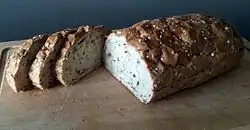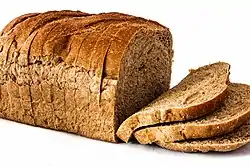 | |
| Type | whole wheat bread |
|---|---|
| Place of origin | Estonia |
Sepik is an Estonian whole wheat bread. Sepik is prepared with wheat flour or with a mixture that can contain wheat, rye, and barley flour. Additionally it can contain bran.[1][2][3][4]
Traditionally the bread was served for the celebrations like New Year, Vastlapäev, or St. Martin's Day.[5][3] The direct predecessor of sepik is a barley bread known in South Estonia as karask.[6]
Many food companies in Estonia and other Baltic states make their own variations of sepik which differ from the traditional Estonian sepik.[7] It has been described as comparable to Graham bread in the U.S.[8][9]
See also
Citations and references
- ↑ Sune 2009, p. 37.
- ↑ Кальвик 1987, p. 28.
- 1 2 "Пища эстонцев" [Food of Estonians] (in Russian). Этнографический блог о народах и странах мира их истории и культуре. Retrieved 2016-06-23.
- ↑ Kärner 2005, p. 163.
- ↑ Кальвик 1987, p. 18.
- ↑ Ränk 1976, p. 48.
- ↑ "Тестируем традиционный эстонский хлеб: какой сепик самый качественный" [Testing traditional Estonian bread] (in Russian). МК-Эстония. 2015-04-14. Retrieved 2016-06-28.
- ↑ Renata Sõukand; Raivo Kalle (7 November 2016). Changes in the Use of Wild Food Plants in Estonia: 18th - 21st Century. Springer. p. 64. ISBN 978-3-319-33949-8.
- ↑ Kärner 2005, p. 319.
Cited sources
- Кальвик, Сильвия (1987). Эстонская кухня [Estonian cuisine] (in Russian). Периодика.
- Sune, Ingrid (2009). Eesti-inglise Eesti köögisõnastik [English-Estonian Culinary Dictionary] (in Estonian). Tartu Ülikool.
- Ränk, Gustav (1976). Old Estonia, the people and culture. Indiana University.
- Kärner, Karin Annus (2005). Estonian Tastes & Traditions. Hippocrene Books. ISBN 9780781811224.
This article is issued from Wikipedia. The text is licensed under Creative Commons - Attribution - Sharealike. Additional terms may apply for the media files.
